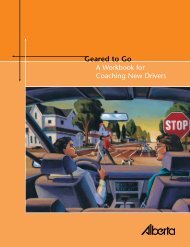Commercial driver's guide to operation, safety and licensing
Commercial driver's guide to operation, safety and licensing
Commercial driver's guide to operation, safety and licensing
Create successful ePaper yourself
Turn your PDF publications into a flip-book with our unique Google optimized e-Paper software.
• Remember, as the driver of the school<br />
bus, you must never leave the bus<br />
without turning off the engine, setting<br />
the brakes, putting the transmission<br />
in its lowest gear (manual) or park<br />
(au<strong>to</strong>matic) position <strong>and</strong> taking<br />
the key out.<br />
• When you are sure that it is safe <strong>to</strong><br />
proceed, select an appropriate low gear.<br />
• Release the park brake.<br />
• Check left <strong>and</strong> right.<br />
• Close the door.<br />
• Cross the tracks.<br />
• If the transmission is manual, do not shift<br />
gears until you are clear of the last track.<br />
Discipline <strong>and</strong> problem<br />
solving<br />
• You are not only responsible for the<br />
<strong>safety</strong> of your passengers, but also<br />
for dealing with their behaviour while<br />
they are in the bus. Many discipline<br />
problems are also <strong>safety</strong> problems<br />
<strong>and</strong> should be h<strong>and</strong>led quickly <strong>and</strong><br />
efficiently. Remember, regardless of<br />
any problems that you may have with a<br />
student, you cannot unload the student<br />
at any place other than the student’s<br />
normal destination. Only the school<br />
administration may remove or prohibit a<br />
student from riding a school bus.<br />
Safe driving <strong>guide</strong>lines<br />
• The maximum speed limit for a loaded<br />
or unloaded school bus, under ideal<br />
conditions, is 90 km/h or the posted<br />
speed limit, whichever is lower.<br />
• Do not try <strong>to</strong> make up lost time by<br />
travelling faster than is reasonable for<br />
road conditions or the law allows.<br />
• When following another vehicle, always<br />
allow enough of a space cushion. Use<br />
the four-second following rule <strong>and</strong><br />
increase this distance when the road or<br />
weather conditions are poor or when it<br />
is difficult <strong>to</strong> see.<br />
• Make sure all students are seated <strong>and</strong><br />
remain seated while the bus is moving.<br />
Everyone must enter or leave the bus<br />
by the front door. The rear door, by law,<br />
should not be used unless there is an<br />
emergency. You <strong>and</strong> your passengers<br />
should know about the emergency<br />
exits, emergency equipment <strong>and</strong><br />
evacuation procedures.<br />
• All doors must be closed when the bus<br />
is moving.<br />
• When moving away from the curb,<br />
use caution, as you do not have the<br />
right-of-way.<br />
• When crossing a highway, do not<br />
proceed until the traffic is clear in<br />
both directions.<br />
• Never refuel a bus with passengers<br />
aboard.<br />
• Establish a good relationship with your<br />
passengers. Your job will be easier<br />
<strong>and</strong> more enjoyable.<br />
• At the beginning of the school year it is<br />
a good idea <strong>to</strong> hold an evacuation drill<br />
with everyone who rides the bus. This<br />
way, the passengers will know what <strong>to</strong><br />
do in case of a real emergency. Hold the<br />
drill in a safe traffic-free area on, or next<br />
<strong>to</strong> the school property. Work with the<br />
school administration <strong>to</strong> set up the drill.<br />
• There are three st<strong>and</strong>ard methods <strong>to</strong><br />
evacuate the bus, although other ways<br />
can be used in extreme situations. The<br />
three methods are: the front exit, the<br />
rear exit <strong>and</strong> the front <strong>and</strong> rear exit at<br />
the same time. In a real situation, you<br />
CHAPTER FIVE<br />
Operating Class 2 vehicles 59




